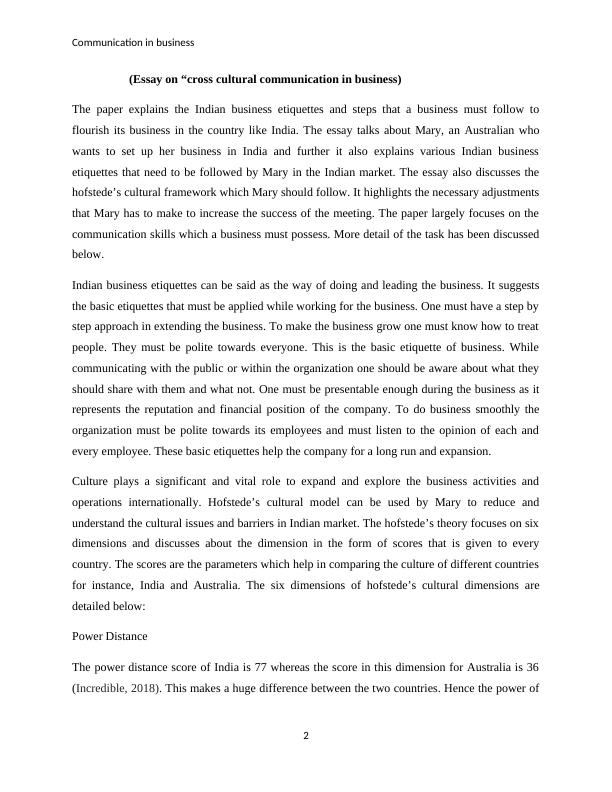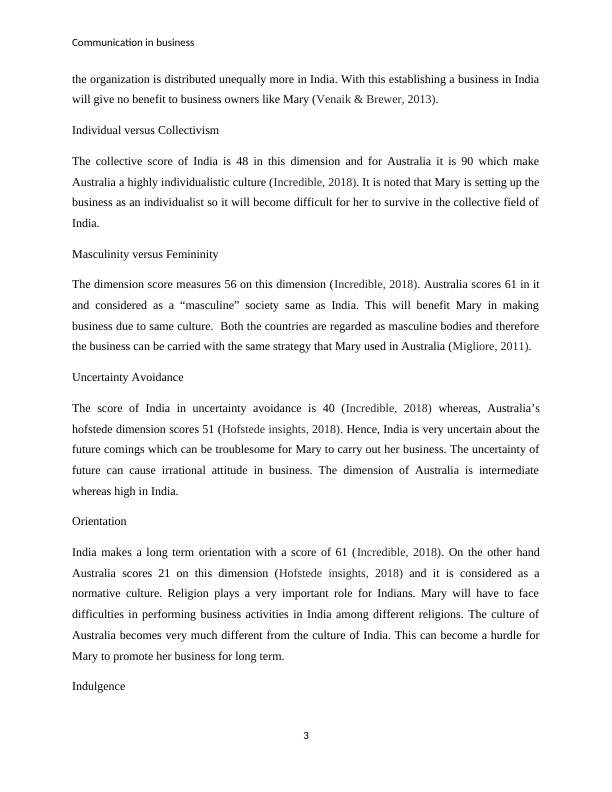Communication in Business: Cross Cultural Communication in India
Added on 2023-06-09
7 Pages2042 Words488 Views
Running head: Communication in business
Communication in business
Communication in business

Communication in business
(Essay on “cross cultural communication in business)
The paper explains the Indian business etiquettes and steps that a business must follow to
flourish its business in the country like India. The essay talks about Mary, an Australian who
wants to set up her business in India and further it also explains various Indian business
etiquettes that need to be followed by Mary in the Indian market. The essay also discusses the
hofstede’s cultural framework which Mary should follow. It highlights the necessary adjustments
that Mary has to make to increase the success of the meeting. The paper largely focuses on the
communication skills which a business must possess. More detail of the task has been discussed
below.
Indian business etiquettes can be said as the way of doing and leading the business. It suggests
the basic etiquettes that must be applied while working for the business. One must have a step by
step approach in extending the business. To make the business grow one must know how to treat
people. They must be polite towards everyone. This is the basic etiquette of business. While
communicating with the public or within the organization one should be aware about what they
should share with them and what not. One must be presentable enough during the business as it
represents the reputation and financial position of the company. To do business smoothly the
organization must be polite towards its employees and must listen to the opinion of each and
every employee. These basic etiquettes help the company for a long run and expansion.
Culture plays a significant and vital role to expand and explore the business activities and
operations internationally. Hofstede’s cultural model can be used by Mary to reduce and
understand the cultural issues and barriers in Indian market. The hofstede’s theory focuses on six
dimensions and discusses about the dimension in the form of scores that is given to every
country. The scores are the parameters which help in comparing the culture of different countries
for instance, India and Australia. The six dimensions of hofstede’s cultural dimensions are
detailed below:
Power Distance
The power distance score of India is 77 whereas the score in this dimension for Australia is 36
(Incredible, 2018). This makes a huge difference between the two countries. Hence the power of
2
(Essay on “cross cultural communication in business)
The paper explains the Indian business etiquettes and steps that a business must follow to
flourish its business in the country like India. The essay talks about Mary, an Australian who
wants to set up her business in India and further it also explains various Indian business
etiquettes that need to be followed by Mary in the Indian market. The essay also discusses the
hofstede’s cultural framework which Mary should follow. It highlights the necessary adjustments
that Mary has to make to increase the success of the meeting. The paper largely focuses on the
communication skills which a business must possess. More detail of the task has been discussed
below.
Indian business etiquettes can be said as the way of doing and leading the business. It suggests
the basic etiquettes that must be applied while working for the business. One must have a step by
step approach in extending the business. To make the business grow one must know how to treat
people. They must be polite towards everyone. This is the basic etiquette of business. While
communicating with the public or within the organization one should be aware about what they
should share with them and what not. One must be presentable enough during the business as it
represents the reputation and financial position of the company. To do business smoothly the
organization must be polite towards its employees and must listen to the opinion of each and
every employee. These basic etiquettes help the company for a long run and expansion.
Culture plays a significant and vital role to expand and explore the business activities and
operations internationally. Hofstede’s cultural model can be used by Mary to reduce and
understand the cultural issues and barriers in Indian market. The hofstede’s theory focuses on six
dimensions and discusses about the dimension in the form of scores that is given to every
country. The scores are the parameters which help in comparing the culture of different countries
for instance, India and Australia. The six dimensions of hofstede’s cultural dimensions are
detailed below:
Power Distance
The power distance score of India is 77 whereas the score in this dimension for Australia is 36
(Incredible, 2018). This makes a huge difference between the two countries. Hence the power of
2

Communication in business
the organization is distributed unequally more in India. With this establishing a business in India
will give no benefit to business owners like Mary (Venaik & Brewer, 2013).
Individual versus Collectivism
The collective score of India is 48 in this dimension and for Australia it is 90 which make
Australia a highly individualistic culture (Incredible, 2018). It is noted that Mary is setting up the
business as an individualist so it will become difficult for her to survive in the collective field of
India.
Masculinity versus Femininity
The dimension score measures 56 on this dimension (Incredible, 2018). Australia scores 61 in it
and considered as a “masculine” society same as India. This will benefit Mary in making
business due to same culture. Both the countries are regarded as masculine bodies and therefore
the business can be carried with the same strategy that Mary used in Australia (Migliore, 2011).
Uncertainty Avoidance
The score of India in uncertainty avoidance is 40 (Incredible, 2018) whereas, Australia’s
hofstede dimension scores 51 (Hofstede insights, 2018). Hence, India is very uncertain about the
future comings which can be troublesome for Mary to carry out her business. The uncertainty of
future can cause irrational attitude in business. The dimension of Australia is intermediate
whereas high in India.
Orientation
India makes a long term orientation with a score of 61 (Incredible, 2018). On the other hand
Australia scores 21 on this dimension (Hofstede insights, 2018) and it is considered as a
normative culture. Religion plays a very important role for Indians. Mary will have to face
difficulties in performing business activities in India among different religions. The culture of
Australia becomes very much different from the culture of India. This can become a hurdle for
Mary to promote her business for long term.
Indulgence
3
the organization is distributed unequally more in India. With this establishing a business in India
will give no benefit to business owners like Mary (Venaik & Brewer, 2013).
Individual versus Collectivism
The collective score of India is 48 in this dimension and for Australia it is 90 which make
Australia a highly individualistic culture (Incredible, 2018). It is noted that Mary is setting up the
business as an individualist so it will become difficult for her to survive in the collective field of
India.
Masculinity versus Femininity
The dimension score measures 56 on this dimension (Incredible, 2018). Australia scores 61 in it
and considered as a “masculine” society same as India. This will benefit Mary in making
business due to same culture. Both the countries are regarded as masculine bodies and therefore
the business can be carried with the same strategy that Mary used in Australia (Migliore, 2011).
Uncertainty Avoidance
The score of India in uncertainty avoidance is 40 (Incredible, 2018) whereas, Australia’s
hofstede dimension scores 51 (Hofstede insights, 2018). Hence, India is very uncertain about the
future comings which can be troublesome for Mary to carry out her business. The uncertainty of
future can cause irrational attitude in business. The dimension of Australia is intermediate
whereas high in India.
Orientation
India makes a long term orientation with a score of 61 (Incredible, 2018). On the other hand
Australia scores 21 on this dimension (Hofstede insights, 2018) and it is considered as a
normative culture. Religion plays a very important role for Indians. Mary will have to face
difficulties in performing business activities in India among different religions. The culture of
Australia becomes very much different from the culture of India. This can become a hurdle for
Mary to promote her business for long term.
Indulgence
3

End of preview
Want to access all the pages? Upload your documents or become a member.
Related Documents
Communication in Businesslg...
|7
|1966
|464
Cultural Differences between China and Australia for Business Communicationlg...
|6
|2188
|373
Business Communication: Etiquettes and Potential Miscommunication in India and Australialg...
|9
|2193
|275
Cross Cultural Communication: Challenges and Strategies for Expanding Business in Chinalg...
|6
|2075
|212
Management in the Global Environmentlg...
|5
|1160
|69
Intercultural Challenges for Australian Humanitarian Workers in Indonesialg...
|12
|2734
|467
